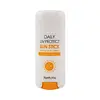What's inside
What's inside
 Key Ingredients
Key Ingredients

 Benefits
Benefits

 Concerns
Concerns

 Ingredients Side-by-side
Ingredients Side-by-side

Octyldodecanol
EmollientZinc Oxide
Cosmetic ColorantCetyl Ethylhexanoate
EmollientBenzotriazolyl Dodecyl P-Cresol
UV AbsorberCoco-Caprylate/Caprate
EmollientC12-15 Alkyl Benzoate
AntimicrobialIsopropyl Palmitate
EmollientAcrylates Copolymer
Butylene Glycol Dicaprylate/Dicaprate
EmollientSilica Silylate
EmollientDibutyl Lauroyl Glutamide
Skin ConditioningDibutyl Ethylhexanoyl Glutamide
Skin ConditioningCaprylic/Capric Triglyceride
MaskingButyloctyl Salicylate
Skin ConditioningDextrin Palmitate
EmulsifyingVinyldimethicone
Vinyl Dimethicone/Methicone Silsesquioxane Crosspolymer
Centella Asiatica Extract
CleansingMentha Viridis Extract
MaskingPinus Pinaster Bark Extract
AntioxidantCaesalpinia Spinosa Fruit Extract
Skin ProtectingKappaphycus Alvarezii Extract
Skin ConditioningBuddleja Officinalis Flower Extract
UV FilterCamellia Sinensis Leaf Extract
AntimicrobialGinkgo Biloba Leaf Extract
Skin ConditioningCamellia Japonica Leaf Extract
Skin ConditioningEruca Sativa Leaf Extract
Skin ConditioningTriticum Vulgare Sprout Extract
Skin ConditioningBrassica Oleracea Italica Sprout Extract
EmollientMedicago Sativa Extract
TonicGlyceryl Caprylate
EmollientTriethoxycaprylylsilane
Polyhydroxystearic Acid
EmulsifyingPolyglyceryl-6 Polyricinoleate
EmulsifyingTocopherol
AntioxidantWater
Skin Conditioning7-Dehydrocholesterol
Emulsion StabilisingEctoin
Skin ConditioningPropanediol
SolventButylene Glycol
HumectantLactobacillus Ferment
Skin Conditioning1,2-Hexanediol
Skin ConditioningParfum
MaskingOctyldodecanol, Zinc Oxide, Cetyl Ethylhexanoate, Benzotriazolyl Dodecyl P-Cresol, Coco-Caprylate/Caprate, C12-15 Alkyl Benzoate, Isopropyl Palmitate, Acrylates Copolymer, Butylene Glycol Dicaprylate/Dicaprate, Silica Silylate, Dibutyl Lauroyl Glutamide, Dibutyl Ethylhexanoyl Glutamide, Caprylic/Capric Triglyceride, Butyloctyl Salicylate, Dextrin Palmitate, Vinyldimethicone, Vinyl Dimethicone/Methicone Silsesquioxane Crosspolymer, Centella Asiatica Extract, Mentha Viridis Extract, Pinus Pinaster Bark Extract, Caesalpinia Spinosa Fruit Extract, Kappaphycus Alvarezii Extract, Buddleja Officinalis Flower Extract, Camellia Sinensis Leaf Extract, Ginkgo Biloba Leaf Extract, Camellia Japonica Leaf Extract, Eruca Sativa Leaf Extract, Triticum Vulgare Sprout Extract, Brassica Oleracea Italica Sprout Extract, Medicago Sativa Extract, Glyceryl Caprylate, Triethoxycaprylylsilane, Polyhydroxystearic Acid, Polyglyceryl-6 Polyricinoleate, Tocopherol, Water, 7-Dehydrocholesterol, Ectoin, Propanediol, Butylene Glycol, Lactobacillus Ferment, 1,2-Hexanediol, Parfum
Polymethyl Methacrylate
Caprylic/Capric Triglyceride
MaskingSilica
AbrasiveOctocrylene
UV AbsorberHomosalate
Skin ConditioningButylene Glycol Dicaprylate/Dicaprate
EmollientDimethicone
EmollientEthylhexyl Salicylate
UV AbsorberParaffin
PerfumingPolyethylene
AbrasiveButyl Methoxydibenzoylmethane
UV AbsorberMicrocrystalline Wax
Emulsion StabilisingBis-Ethylhexyloxyphenol Methoxyphenyl Triazine
Skin ConditioningVinyl Dimethicone/Methicone Silsesquioxane Crosspolymer
Euphorbia Cerifera Wax
Silica Dimethyl Silylate
EmollientAdenosine
Skin ConditioningGlycerin
HumectantDipropylene Glycol
HumectantGlycyrrhiza Glabra Root Extract
BleachingWater
Skin ConditioningHydrogenated Lecithin
EmulsifyingPolyglyceryl-10 Oleate
Skin ConditioningMethicone
EmollientParfum
MaskingPolymethyl Methacrylate, Caprylic/Capric Triglyceride, Silica, Octocrylene, Homosalate, Butylene Glycol Dicaprylate/Dicaprate, Dimethicone, Ethylhexyl Salicylate, Paraffin, Polyethylene, Butyl Methoxydibenzoylmethane, Microcrystalline Wax, Bis-Ethylhexyloxyphenol Methoxyphenyl Triazine, Vinyl Dimethicone/Methicone Silsesquioxane Crosspolymer, Euphorbia Cerifera Wax, Silica Dimethyl Silylate, Adenosine, Glycerin, Dipropylene Glycol, Glycyrrhiza Glabra Root Extract, Water, Hydrogenated Lecithin, Polyglyceryl-10 Oleate, Methicone, Parfum
 Reviews
Reviews

Ingredients Explained
These ingredients are found in both products.
Ingredients higher up in an ingredient list are typically present in a larger amount.
We don't have a description for Butylene Glycol Dicaprylate/Dicaprate yet.
This ingredient is an emollient, solvent, and texture enhancer. It is considered a skin-softener by helping the skin prevent moisture loss.
It helps thicken a product's formula and makes it easier to spread by dissolving clumping compounds.
Caprylic Triglyceride is made by combining glycerin with coconut oil, forming a clear liquid.
While there is an assumption Caprylic Triglyceride can clog pores due to it being derived from coconut oil, there is no research supporting this.
Learn more about Caprylic/Capric TriglycerideParfum is a catch-all term for an ingredient or more that is used to give a scent to products.
Also called "fragrance", this ingredient can be a blend of hundreds of chemicals or plant oils. This means every product with "fragrance" or "parfum" in the ingredients list is a different mixture.
For instance, Habanolide is a proprietary trade name for a specific aroma chemical. When used as a fragrance ingredient in cosmetics, most aroma chemicals fall under the broad labeling category of “FRAGRANCE” or “PARFUM” according to EU and US regulations.
The term 'parfum' or 'fragrance' is not regulated in many countries. In many cases, it is up to the brand to define this term.
For instance, many brands choose to label themselves as "fragrance-free" because they are not using synthetic fragrances. However, their products may still contain ingredients such as essential oils that are considered a fragrance by INCI standards.
One example is Calendula flower extract. Calendula is an essential oil that still imparts a scent or 'fragrance'.
Depending on the blend, the ingredients in the mixture can cause allergies and sensitivities on the skin. Some ingredients that are known EU allergens include linalool and citronellol.
Parfum can also be used to mask or cover an unpleasant scent.
The bottom line is: not all fragrances/parfum/ingredients are created equally. If you are worried about fragrances, we recommend taking a closer look at an ingredient. And of course, we always recommend speaking with a professional.
Learn more about ParfumThis ingredient is used in makeup and skincare to thicken formulas, reduce shine, and give skin a silky-smooth feel.
It’s a white silicone powder that sits in fine lines and pores to blur their appearance though its effectiveness depends on the particle size.
You'll typically find this ingredient in amounts between 0.1-20%.
Learn more about Vinyl Dimethicone/Methicone Silsesquioxane CrosspolymerWater. It's the most common cosmetic ingredient of all. You'll usually see it at the top of ingredient lists, meaning that it makes up the largest part of the product.
So why is it so popular? Water most often acts as a solvent - this means that it helps dissolve other ingredients into the formulation.
You'll also recognize water as that liquid we all need to stay alive. If you see this, drink a glass of water. Stay hydrated!
Learn more about Water